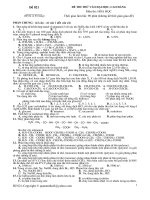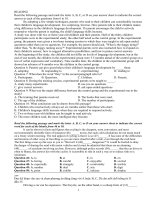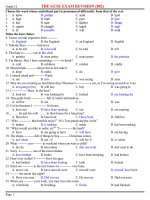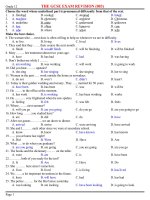GCSE 021
Bạn đang xem bản rút gọn của tài liệu. Xem và tải ngay bản đầy đủ của tài liệu tại đây (73.07 KB, 5 trang )
SƠ GD&ĐT VINH PHUC
TRƯƠNG THPT LIÊN SƠN
(Đề thi gồm: 05 trang)
ĐỀ KTCL ƠN THI THPT QUỐC GIA NĂM 20182019
Mơn: TIẾNG ANH – ĐỀ SỐ 021
Thời gian làm bài: 60 phút, không kể thời gian phát
đề
Ho va tên thi sinh:……………………………………………………………………. SBD:…………………………
Mark the letter A, B, C, or D on your answer sheet to indicate the word whose underlined part
differs from the other three in pronunciation in each of the following questions.
Question 01. A. study
B. success
C. surprise
D. sugar
Question 02. A. yacht
B. watch
C. wash
D. wall
Mark the letter A, B, C or D on your answer sheet to indicate the word that differs from the rest
in the position of the main stress in each of the following questions.
Question 03: A. secretary
B. necessary
C. classifies
D. vocabulary
Question 04: A. endangered
B. humidity
C. interested
D. incredible
Mark the letter A, B, C, or D on your answer sheet to indicate the correct answer to each of the
following questions.
Question 05: By tomorrow, the car________ by me.
A. will have been bought
B. will be bought C. was being bought
D. was bought
Question 06: The activities of the international marketing researcher are frequently much broader
than________.
A. the domestic marketer has
B. the domestic marketer does
C. those of the domestic marketer
D. that which has the domestic marketer
Question 07: "________ anyone ring while I’m away, please take a message."
A. Will
B. May
C. Should
D. Would
Question 08: She had to pass all her exams, or________ she would not have a holiday.
A. instead
B. else
C. though
D. therefore
Question 09: My uncle was________ ill last summer; however, fortunately, he is now making a slow but
steady recovery.
A. seriously
B. deeply
C. fatally
D. critically
Question 10: ________ wooden buildings helps to protect them from damage due to weather.
A. The paint
B. Painted
C. By painting
D. Painting
Question 11. I met a________ girl at my friend's birthday party last Sunday.
A. tall American pretty
B. tall pretty American
C. pretty American tall
D. pretty tall American
Question 12: George won five medals at the competition. His parents________ very proud of him.
A. could have been B. can’t have
C. can’t be
D. must have been
Question 13: We hire our bicycle________.
A. by the hour
B. by hours
C. by an hour
D. for hours
Question 14: My decision to leave university after a year is one I now________ regret.
A. harshly
B. painfully
C. keenly
D. heavily
Question 15: He kept his marriage for years, but eventually the truth________.
A. came out
B. went out
C. came through
D. fell out
Question 16. The larger the area of forest is destroyed, ________.
A. the most frequent natural disasters are
B. the more frequent are natural disasters
C. the more frequently natural disasters occur D. the most frequently natural disasters occur
Mark the letter A, B, C, or D on your answer sheet to indicate the most suitable response to
complete each of the following exchanges in each of the following question.
Question 17: Jenifer and Susan are talking about a book they have just read.
Jennifer: “ The book is really interesting and it’s hard to put it down.”- Susan: “_____________”
A. Don’t mention it.
B. I couldn’t agree with you more.
C. That’s nice of you to say so.
D. It’s alright.
Question 18: Peter: “My mother’s much better now.”
- Kyle: “_____________”
A. Oh, I’m pleased to hear it
B. Oh, really? The doctor must be very good
C. Wonderful! Congratulations
D. Good news for you
Mark the letter A, B, C or D on your answer sheet to indicate the word or phrase that is CLOSEST
in meaning to the underlined part in each of the following question.
Question 19: Dozens of applicants showed up for the vacant position, but only a handful of them
were shortlisted for the interview.
A. small amount
B. person
C. hand
D. small number
Question 20: He made one last futile effort to convince her and left home.
A. favorable
B. difficult
C. ineffectual
D. firm
Mark the letter A, B, C or D on your answer sheet to indicate the word or phrase that is
OPPOSITE in meaning to the underlined part in each of the following questions.
Question 21: A frightening number of illiterate students are graduating from college.
A. able to read and write
B. able to join intramural sport
C. inflexible
D. unable to pass an examination in reading and writing
Question 22: You should put yourself on the back for having achieved such a high score in the graduation
exam.
A. criticize yourself B. wear a backpack
C. praise yourself
D. check up your back
Mark the letter A, B, C, or D on your answer sheet to indicate the underlined part that needs
correction in each of the following questions.
Question 23. They are very pleasant to travel by steamer down the Thames from Westminster to
Tower Bridge.
A. They are
B. pleasant
C. down
D. to
Question 24. Studying the science of logic is one way to cultivate one’s reason skills.
A. Studying
B. science of
C. way to
D. reason
Question 25. One day a fame singer was invited by a rich lady to her house.
A. One day
B. fame
C. was
D. by
Mark the letter A, B, C, or D on your answer sheet to indicate the sentence that is closest in
meaning to each of the following questions.
Question 26: The police questioned two men but neither of them could speak English.
A. The police questioned two Englishmen in English.
B. The police questioned two men who could not speak English.
C. Neither of the Englishmen was questioned by the police.
D. Either of the men could answer the police questions in English.
Question 27: The purpose of any invention is to make our lives better, so good or bad, it depends on the
way by which we use these inventions.
A. Whether an invention is good or bad depends on the way by which we use it because the
purpose of any invention is to make our lives better.
B. We can use either good or bad inventions to make our lives better.
C. The purpose of any invention, whether good or bad, is to make our lives better. This
depends on the way by which we use these inventions.
D. Good or bad as they are, all inventions have the same purpose to make our lives better.
Question 28: California attracted people from many countries when gold was discovered in 1848.
A. Discovered in 1848, gold was attractive to people in California.
B. Discovered in California in 1848, gold attracted people from many countries there.
C. Gold in California was discovered in 1848 after many people came here.
D. When people are attracted to California, they discovered gold in 1848.
Mark the letter A, B, C, or D on your answer sheet to indicate the sentence that best combines
each pair of sentences in the following questions.
Question 29: My sister didn’t leave the car key. As a result, I couldn’t pick her up at the airport.
A. If my sister left the car key, I would pick her up at the airport.
B. If my sister had left the car key, I would have picked her up at the airport.
C. If my sister have left the car key, I would have picked her up at the airport.
D. If my sister had left the car key, I could pick her up at the airport.
Question 30: Women still cover their heads in some countries. They did so in the past.
A. In the past, women cover their heads but they do so today in some countries.
B. Women still cover their heads in some countries as they did in the past.
C. Women still cover their heads in some countries similar to what they did so in the past.
D. Women still cover their heads in some countries as they did so in the past.
Read the following passage and mark the letter A, B, C, or D on your answer sheet to indicate
the correct word or phrase that best fits each of the numbered blanks from 31 to 35.
In 1830, there were under 100 miles of public railway in Britain. Yet within 20 years, this
figure had grown to more than 5000 miles. By the end of the century, almost enough rail track to
encircle the world covered this small island, (31)__________ the nature of travel forever and
contributing to the industrial revolution that changed the course of history in many parts of the
world.
Wherever railways were introduced, economic and social progress quickly (32)__________ In a
single day, rail passengers could travel hundreds of miles, cutting previous journey times by huge
margins and bringing rapid travel within the (33)__________ of ordinary people. Previously, many
people had never ventured beyond the outskirts of their town and villages. The railway brought
them greater freedom and enlightenment.
In the 19th century, the railway in Britain represented something more than just the business
of carrying goods and passengers. Trains were associated with romance, adventure and, frequently,
(34)__________ luxury. But the railways did more than revolutionize travel; they also left a distinctive
and permanent mark on the British landscape. Whole towns and industrial centers (35)__________ up
around major rail junctions, monumental bridges and viaducts crossed rivers and valleys and the
railway stations themselves became desirable places to spend time between journeys.
Question 31. A. altering
B. amending
C. adapting
D. adjusting
Question 32. A. pursued
B. followed
C. succeeded
D. chased
Question 33. A. reach
B. capacity
C. facility
D. hold
Question 34. A. considerable
B. generous
C. plentiful
D. sizeable
Question 35. A. jumped
B. stood
C. burst
D. sprang
Read the following passage and mark the letter A, B, C, or D on your answer sheet to indicate
the correct answer to each of the questions from 36 to 42.
The food we eat seems to have profound effects on our health. Although science has made
enormous steps in making food more fit to eat, it has, at the same time, made many foods unfit to
eat. Some research has shown that perhaps eighty percent of all human illnesses are related to diet
and forty percent of cancer is related to the diet as well, especially cancer of the colon. People of
different cultures are more prone to contact certain illnesses because of the characteristic foods
they consume.
That food is related to illness is not a new discovery. In 1945, government researchers realized that
nitrates nitrites (commonly used to preserve color in meat) as well as other food additives caused
cancer. Yet, these carcinogenic additives remain in our food, and it becomes more difficult all the
time to know which ingredients on the packaging label of processed food are helpful or harmful.
The additives that we eat are not all so direct. Farmers often give penicillin to cattle and
poultry, and because of this, penicillin has been found in the milk of treated cows.
Sometimes similar drugs are administered to animals not for medical purposes, but for
financial reasons. The farmers are simply trying to fatten the animals in order to obtain a higher
price on the market. Although the Food and Drug Administration (FDA) has tried repeatedly to
control these procedures, the practices continue.
A healthy diet is directly related to good health. Often we are unaware of detrimental
substances we ingest. Sometimes well-meaning farmers or others who do not realize the
consequences add these substances to food without our knowledge.
Question 36: How has science done to disservice to people?
A. As a result of scientific intervention, some potentially harmful substances have been added
to our food
B. The scientists have preserved the color of meats, but not of vegetables
C. It caused a lack of information concerning the value of food
D. Because of science, disease caused by contaminated food has been virtually eradicated.
Question 37: What are nitrates used for?
A. They preserve the color of meat
B. They preserve flavor in package food
C. The are objects of research
D. They cause the animals become fatter
Question 38: FDA means___________.
A. Federal Dairy Additives
B. Food and Drug Administration
C. Final Difficult Analysis
D. Food Direct Additives
Question 39: All of the following statements are TRUE except___________.
A. Drug are always given to animals for medical reasons
B. Food may cause forty percent of the cancer in the world
C. Researchers have known about the potential hazard of food additives for more than 45
years
D. Some of the additives in our food are added to the food itself and some are given to the
living animals
Question 40: What is best title for this passage?
A. The food you eat can affect your health
B. Harmful and Harmless substances in
food
C. Avoiding injurious substances in food
D. Improving health through a Natural Diet
Question 41: The word “these” refers to___________?
A. researchers
B. nitrates and nitrites
C. meats
D. colors
Question 42: The word “additives” is closest meaning to_________.
A. begin substance B. natural substance C. dangerous substance D. added substance
Read the following passage and mark the letter A, B, C, or D on your answer sheet to indicate
the correct answer to each of the questions from 43 to 50.
What we today call American folk art was, indeed, art of, by, and for ordinary, everyday
“folks” who, with increasing prosperity and leisure, created a market for art of all kinds, and
especially for portraits. Citizens of prosperous, essentially middle-class republics - whether ancient
Romans, seventeenth-century Dutch burghers, or nineteenth-century Americans - have always
shown a marked taste for portraiture. Starting in the late eighteenth century, the United States
contained increasing numbers of such people, and of the artists who could meet their demands. The
earliest American folk art portraits come, not surprisingly, from New England - especially
Connecticut and Massachusetts - for this was a wealthy and populous region and the center of a
strong craft tradition. Within a few decades after the signing of the Declaration of Independence in
1776, the population was pushing westward, and portrait painters could be found at work in
western New York, Ohio,
Kentucky, Illinois, and Missouri. Midway through its first century as a nation, the United
States' population had increased roughly five times, and eleven new states had been added to the
original thirteen. During these years the demand for portraits grew and grew eventually to be
satisfied by the camera. In 1839 the daguerreotype was introduced to America, ushering in the age
of photography, and within a generation the new invention put an end to the popularity of painted
portraits. Once again an original portrait became a luxury, commissioned by the wealthy and
executed by the professional.
But in the heyday of portrait painting - from the late eighteenth century until the 1850's anyone with a modicum of artistic ability could become a limner, as such a portraitist was called.
Local craftspeople - sign, coach, and house painters - began to paint portraits as a profitable
sideline; sometimes a talented man or woman who began by sketching family members gained a
local reputation and was besieged with requests for portraits; artists found it worth their while to
pack their paints, canvases, and brushes and to travel the countryside, often combining house
decorating with portrait painting.
Question 43. In the passage the author mentions seventeenth-century Dutch burghers as an
example of a group that________.
A. consisted mainly of self-taught artists
B. appreciated portraits
C. influenced American folk art
D. had little time for the arts
Question 44. According to the passage, where were many of the first American folk art portraits
painted?
A. In western New York
B. In Illinois and Missouri
C. In Connecticut and Massachusetts
D. In Ohio
Question 45. How much did the population of the United States increase in the first fifty years
following independence?
A. It became three times larger.
B. It became five times larger.
C. It became eleven times larger.
D. It became thirteen times larger.
Question 46. The phrase “ushering in” in the passage is closest in meaning to________.
A. beginning
B. demanding
C. publishing
D. increasing
Question 47. The relationship between the daguerreotype and the painted portrait is similar to the
relationship between the automobile and the________.
A. highway
B. driver
C. engine
D. horse-drawn carriage
Question 48. According to the passage, which of the following contributed to a decline in the
demand for painted portrait?
A. The westward migration of many painters
B. The lack of a strong craft tradition
C. The growing preference for landscape paintings
D. The invention of the camera
Question 49. The author implies that most limners________.
A. received instruction from traveling teachers B. were women
C. were from wealthy families
D. had no formal art training
Question 50. The phrase “worth their while” in the passage is closest in meaning to________.
A. essential
B. educational
C. profitable D. pleasurable
_________THE END_________









